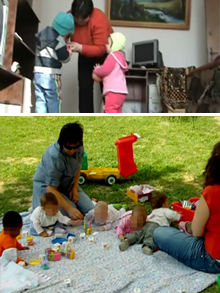
|
The Secure Base Model
Developing family like groups and continuity in social relations |
|
|
|
| Competences to be exercised | |
| • To understand the two basic premises for healthy child development • To discuss and plan what you can do to obtain these premises in your organization |
|
| Theme of the session | |
| In this training session you will work with understanding the two basic needs for children: personal long term relations to a few stable caregivers, and the sense of belonging to a group of peers and caregivers. You will then discuss and maybe revise work schedules to find the best balance between what is possible for staff and leader (depending on local legislation and collective agreements for work hours), and children’s need for having the same caretakers during the day and the year. The leader and people responsible for knowing work schedules participate in this session. | |
| Aims of the session | |
| All human beings – and especially children placed outside home – have two very basic social needs if they are to learn healthy attachment and become active members of society: 8 The need for stable relations to a few specific adult caregivers This is especially important for the formation of secure attachment in children younger than three. 8 The need for belonging to a specific group of peers and adults For children older than two years, group relations become just as important as having stable relations to a “parent figure” caretaker. These two functions we can call continuity in the child’s social relations. The goal is to discuss and (at some point in the future) decide how you can find the best possible work plans and schedules to offer caretaker and group continuity in the way you organize daily work and shifts. So certain groups of children have certain caretakers for long periods in the daytime. | |
|
institutions.fairstartedu.us

 English
English






